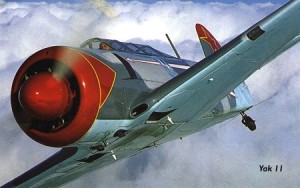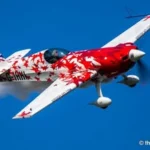“Had the great pleasure of a ten minute zoom with 4 times British aerobatic champion Mark Jefferies in his fantastic Yak-11 two-seat Soviet air combat trainer of 1957 flying from his airfield at Little Gransden yesterday, while he was checking the aeroplane out following some minor adjustments. Brilliant noise from the 700hp ash 21 radial engine, cavorting around the clouds at up to 320kts with 3,000ft loops, rolls and dives. I ran a Yak-55M many years ago in UK and international aerobatic championships, but this one is the real ‘Daddy’ with lots more grunt and ‘pizzaz’! Thanks Mark, a few minutes to treasure in the memory bank – and good luck with the Children in Need show on 26th August, a truly great cause.” Nick Buckenham BAeA
PS: Mark will be flying the YAK 11 in the show on the 26th August.
The YAK 11
The Yakovlev Yak-11 (NATO reporting name: “Moose”, Russian: Як-11) was a trainer aircraft used by the Soviet Air Force and other Soviet-influenced air forces from 1947 until 1962.
The Yakovlev design bureau began work on an advanced trainer based on the successful Yak-3 fighter in mid 1944, although the trainer was of low priority owing to the ongoing Second World War. The first prototype of the new trainer, designated Yak-UTI or Yak-3UTI flew in late 1945. It was based on the radial-powered Yak-3U, but with the new Shvetsov ASh-21 seven-cylinder radial replacing the ASh-82 of the Yak-3U. It used the same all-metal wings as the Yak-3U, with a fuselage of mixed metal and wood construction. Pilot and observer sat in tandem under a long canopy with separate sliding hoods. A single synchronised UBS 12.7 mm machine gun and wing racks for two 100 kg (220lb) bombs comprised the aircraft’s armament.
An improved prototype flew in 1946, with revised cockpits and a modified engine installation with the engine mounted on shock absorbing mounts. This aircraft successfully passed state testing in October 1946, with production beginning at factories in Saratov and Leningrad in 1947.
Production Yak-11s were heavier than the prototypes, with later batches fitted with non-retractable tail wheels and revised propellers. A 7.62 mm ShKAS machine gun was sometimes fitted instead of the UBS, while some were fitted with rear-view periscopes above the windscreen. In total, Soviet production amounted to 3,859 aircraft between 1947 and 1955. with a further 707 licence-built by Let in Czechoslovakia as the C-11.
In 1951, Yakovlev revised the design of the Yak-11, adding a retractable tricycle landing gear, with two variants proposed, the Yak-11U basic trainer and Yak-11T proficiency trainer, which carried similar equipment to contemporary jet fighters. The new aircraft had reduced fuel capacity and was unsuitable for operations on rough or snow covered runways, and so was rejected for Soviet service, although a few examples were built in Czechoslovakia as the C-11U.
The Yak-11 entered service in 1947, serving as a standard advanced trainer with the Soviet Air Forces and DOSAAF. Both Yak-11 and C-11 were used in all Warsaw Pact countries and were exported to eighteen countries, including many African, Middle Eastern and Asian countries.
North Korean Yak-11s were used in combat in the Korean War, with one Yak-11 being the first North Korean aircraft shot down by US forces when it was shot down by a North American F-82 Twin Mustang over Kimpo Airfield on 27 June 1950. East Germany used the Yak-11 to intercept American reconnaissance balloons.
Due to its Yak-3 lineage, the Yak-11 has recently seen widespread popularity among warbird enthusiasts and the Yak-11 can be frequently seen at air races. About 120 Yak-11s remain in airworthy condition.




 WhatsApp me
WhatsApp me
You must be logged in to post a comment.